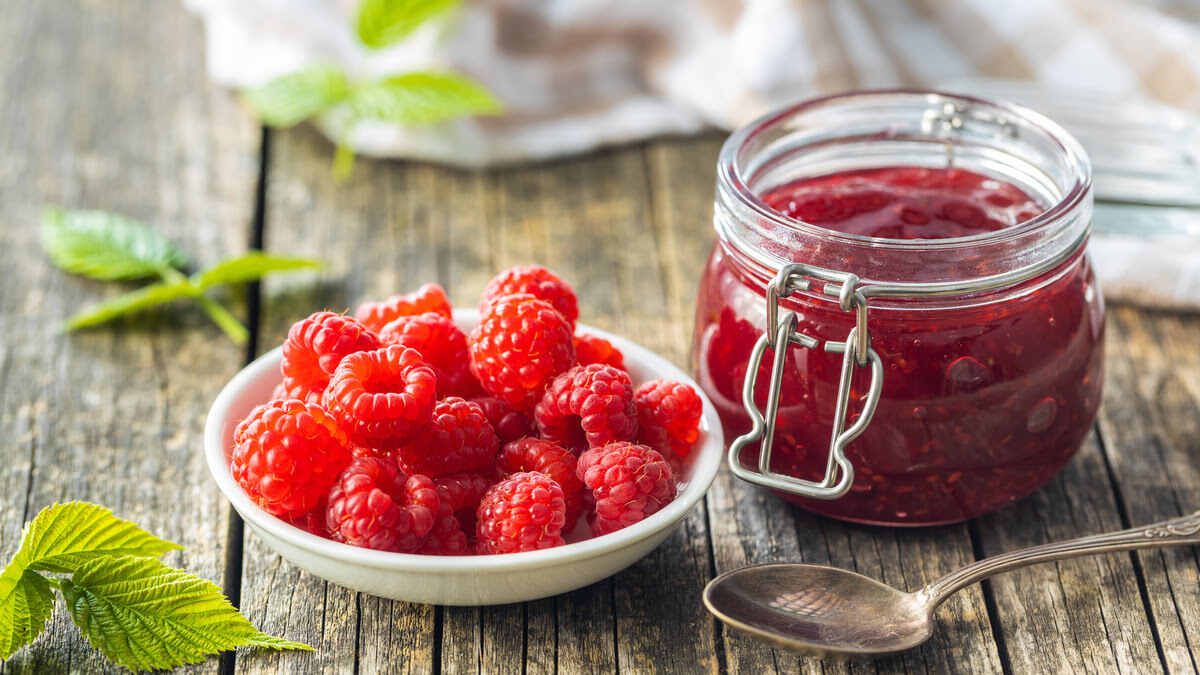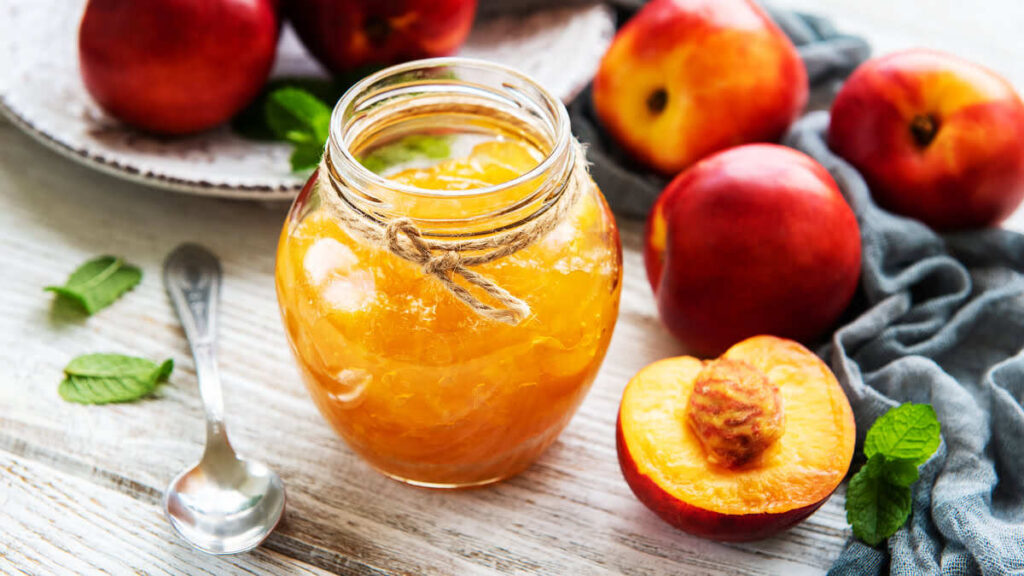
Pectin is a natural, plant-based ingredient that has been used for years in home kitchens and the food industry alike. Thanks to its gelling properties, it serves as a popular alternative to gelatin, agar, and guar gum. It is widely used in the production of marmalades, jellies, jams, and other preserves, giving them the desired structure and texture.
But what exactly is pectin, how does it work, and how can you use it in everyday cooking? In this article, we explain how to use pectin step by step, how it differs from other thickeners, and which properties have made it so popular.
What Is Pectin?
Pectin is a natural chemical compound classified as a polysaccharide, found in plants – especially in their cell walls and intercellular spaces. It plays an important role in maintaining tissue hydration and serves as a structural component that gives plants flexibility and elasticity.
The highest concentrations of pectin are found in citrus peels, apples, currants, gooseberries, sugar beets, and in the hulls of legume seeds such as soybeans. Pectin is considered a type of soluble fiber and is valued for its gelling properties, which are widely used in fruit preserves and dessert production.
Although today we know it as “pectin”, in the past it was called “krzepnik” in Polish. The current name comes from the Greek word pektos, meaning “congealed” – a perfect reflection of this substance’s key characteristic.
Types of Pectin
Pectin comes in several main types that differ in chemical structure and functional properties, and thus in their applications. The key distinction lies in the degree of esterification – that is, the number of methyl groups attached to the pectin molecules.
- High methoxyl pectin (HM) requires both sugar and acid to gel. It’s ideal for traditional fruit preserves like jams and jellies, which typically contain a high sugar content. This is the most common type of pectin found in commercial products.
- Low methoxyl pectin (LM) doesn’t require much sugar to form a gel – only the presence of calcium ions. This makes it suitable for low-sugar and diet-friendly preserves.
- There is also amidated low methoxyl pectin (LM amidated), which offers increased resistance to changes in temperature and pH. Its flexibility makes it popular in modern food formulations.
- A special subtype is NH pectin, which can be reheated and reset without losing its gelling abilities. It’s ideal for glazes, confectionery fillings, and products that need to be heated after setting.
How to Use Pectin?
Pectin, whether naturally sourced or industrially produced, is a versatile additive used in both home kitchens and the food industry. It works exceptionally well as a gelling and thickening agent in homemade jams, preserves, jellies, fruit mousses, and pastry fillings. It’s also commonly used in glazes, icings, and creams to provide the right texture and stability.

The typical amount of pectin used in preserves ranges from 10 to 20 grams per kilogram of fruit. The exact proportion depends on the type of pectin and the desired final consistency. Some fruits, such as apples or currants, naturally contain more pectin, which may require adjusting the recipe.
Pectin has no smell or strong taste, making it a neutral addition that doesn’t alter the character of a dish. Instead, it enhances the sensory qualities of the food by improving structure and extending shelf life. This makes it a favorite not only among home cooks but also among professionals in the pastry and culinary fields.
How to Dissolve Pectin?
The method for dissolving pectin depends primarily on its form and type. It’s available commercially as powder, liquid, or ready-made mixes combined with sugar.
Powdered pectin is most commonly mixed with sugar to prevent clumping and ensure even distribution throughout the fruit mixture. In some cases, it needs to be dissolved in a small amount of water – either cold or warm – depending on the manufacturer’s instructions.
Some types of pectin require heating or even boiling to activate their gelling properties, while others work at lower temperatures. This allows them to be used in more delicate recipes without compromising fruit aroma or product texture.
One of pectin’s major advantages is its resistance to both high temperatures and freezing. It performs well in baked goods and frozen desserts, making it suitable for a wide range of products that require a stable, elastic consistency.
Is Pectin Vegan?
Yes, pectin is a plant-based ingredient and can be safely consumed by people following vegan or vegetarian diets. Unlike gelatin, which is derived from animal tissues, pectin is extracted from fruits – most commonly apples, citrus peels, or other plant skins.
One of pectin’s key advantages is that it doesn’t alter the flavor or aroma of dishes, making it a particularly neutral additive. Its versatility has made it a favorite among pastry chefs and food manufacturers aiming to appeal to a broad audience – regardless of lifestyle or dietary preferences. Thanks to pectin, it’s easy to create delicious, fully plant-based desserts, jams, and jellies. Today, pectin is one of the most popular gelatin alternatives alongside agar.
Is Pectin Healthy?
Pectin is considered a safe substance that is well tolerated by the human body. When consumed in reasonable amounts, it typically does not cause side effects, although – as with all types of fiber – excessive intake may lead to temporary digestive discomfort such as bloating or loose stools. Nevertheless, due to its physiological benefits, pectin is classified as a functional food that supports digestive health.
As a form of soluble fiber, pectin provides a number of health benefits. Once ingested, it absorbs water and expands in the digestive tract, prolonging satiety, regulating appetite, and promoting regular bowel movements – all of which are valued in weight loss diets. It also acts as a prebiotic, supporting the growth of beneficial gut bacteria. Pectin slows glucose absorption in the small intestine, helping maintain stable blood sugar levels. Its ability to bind bile acids contributes to lowering cholesterol. Additionally, pectin aids in detoxification by helping eliminate heavy metals such as lead and mercury from the body.
How Does Pectin Affect the Human Body?
As a form of soluble fiber, pectin has numerous physiological effects on the human body. After consumption, it resists digestion in the stomach and small intestine, reaching the colon largely unchanged. There, it undergoes partial fermentation by gut microbiota, producing short-chain fatty acids such as butyric, propionic, and acetic acids.
Each of these acids serves different biological functions:
- butyric acid is the main energy source for cells in the colon,
- propionic acid may help reduce cholesterol synthesis in the liver,
- acetic acid exhibits antibacterial properties.
These substances also support water and electrolyte absorption, helping relieve diarrhea, while stimulating intestinal motility – making pectin effective in alleviating constipation as well.
How Much Does Pectin Cost?
The price of pectin depends primarily on its type, form, and where it’s purchased. Natural pectin is available in health food stores – both brick-and-mortar and online. The cost is typically several pounds per 100 grams, which is enough to make several batches of preserves. Usually, 10 to 20 grams are used per kilogram of fruit, making it a fairly economical ingredient.
Many supermarkets also offer ready-to-use gelling sugars – mixtures of pectin, sugar, acidity regulators, and preservatives. These are typically sold at a low cost per portion, sufficient for processing 1 kg of fruit. While the price difference between pure pectin and ready-made mixes is relatively small, the ingredient lists can vary significantly – especially for those avoiding additives like sodium benzoate or sorbic acid.
Regardless of which option you choose, both pure pectin and commercial blends allow for easy, quick preparation of homemade preserves. Most manufacturers include clear instructions on the packaging, making the process even simpler.
Homemade Pectin
For those looking for natural and eco-friendly options, making pectin at home is a great alternative to store-bought products. This method not only helps use up fruit leftovers but also gives you full control over the final product’s ingredients – without unnecessary additives or preservatives.

Apple scraps, such as peels, cores, or pulp left over from juicing, work best for homemade pectin. Use about 175 ml of water per kilogram of these raw materials. Simmer gently under a lid for 20-25 minutes without bringing the mixture to a full boil. Once cooked, let the mixture cool and strain it through a fine sieve or cheesecloth. Leave it to drain for several hours – or ideally overnight – so the liquid separates naturally from the solids.
The resulting liquid is natural pectin, ready to use in jams, jellies, or fruit mousses. You can also reheat it and pour it into sterilized jars, then pasteurize for longer storage. This homemade extract is not only a healthy and budget-friendly alternative to commercial thickeners but also a great way to reduce food waste.
Alternatives to Pectin
Although pectin is a popular natural gelling agent, it’s not the only substance with such properties. There are many alternatives that can serve a similar purpose in cooking and food manufacturing – both plant-based and animal-derived.
One of the most commonly used substitutes is gelatin, a collagen protein derived from animal products. It requires low temperatures to set and gives desserts a delicate, bouncy texture. However, it is not suitable for vegans and vegetarians, which is why plant-based options are becoming increasingly popular.
Among these, agar is worth mentioning. Derived from red algae, it gels at room temperature and doesn’t require added sugar – making it ideal for many dietary recipes. Another option is starch – such as corn or potato starch – widely used as a thickener in sauces, puddings, or fruit compotes.
Depending on the recipe, desired outcome, and dietary needs, any of these substances can replace pectin – though each differs in how it works, as well as in the flavor and texture it imparts to the final product.
Pectin | Summary
Pectin is a versatile, natural ingredient that plays a valuable role not only in cooking but also in maintaining a healthy diet. Thanks to its gelling and stabilizing properties, it’s widely used in the preparation of homemade preserves, desserts, and a variety of food products. Its plant origin makes it a great option for those following a vegan diet, while its numerous health benefits – from supporting digestion to regulating cholesterol – have made it popular among advocates of functional foods.
Whether you choose to use a ready-made product or prepare pectin at home, it’s worth keeping this ingredient in your pantry. It’s a natural way to improve the consistency of dishes while supporting wellness and reducing the number of artificial additives in your diet.



